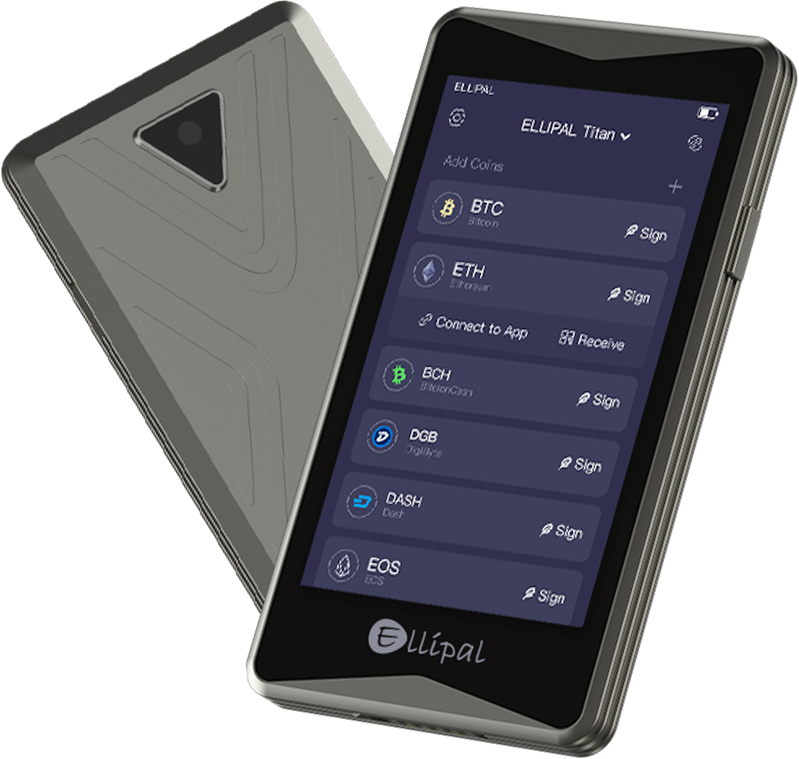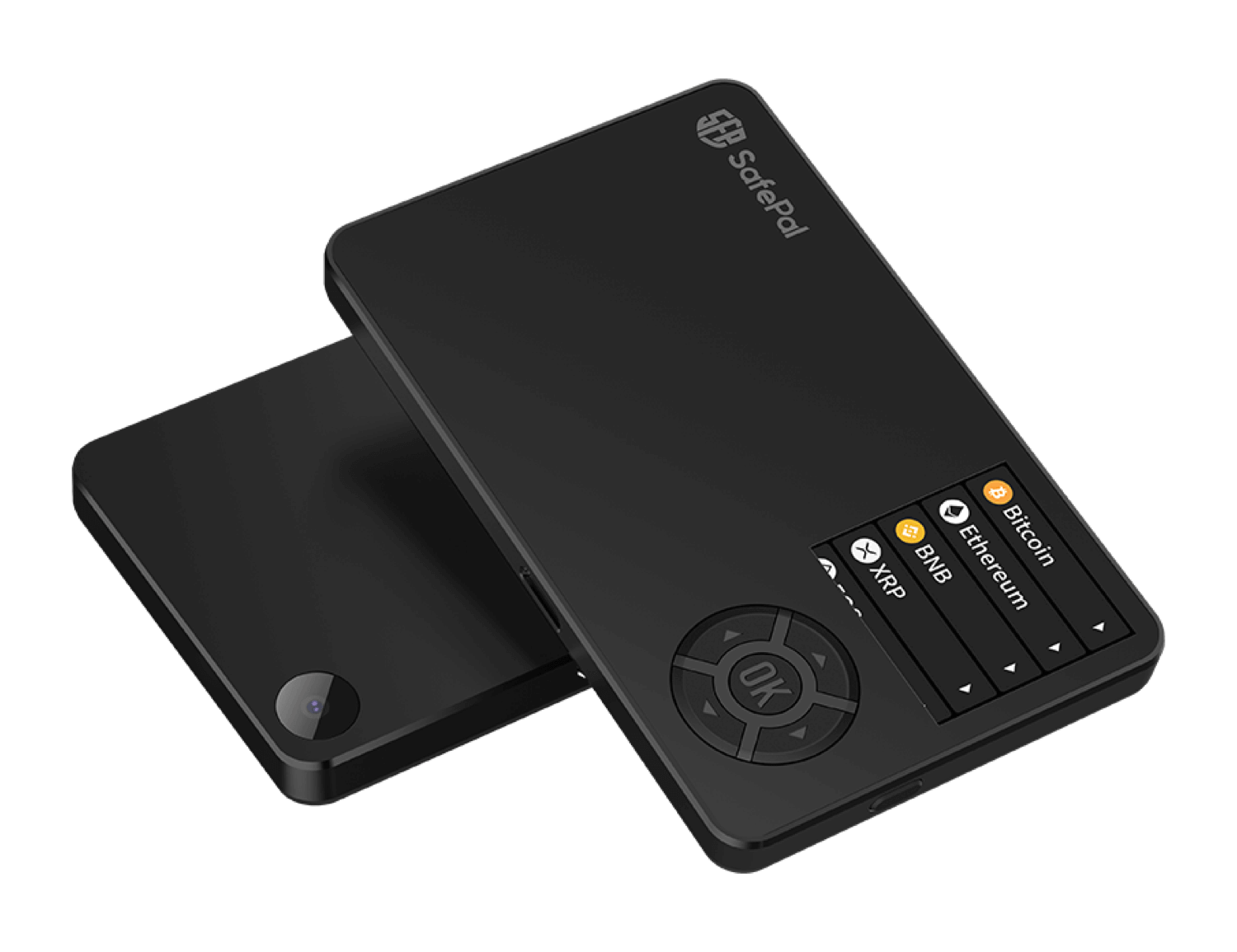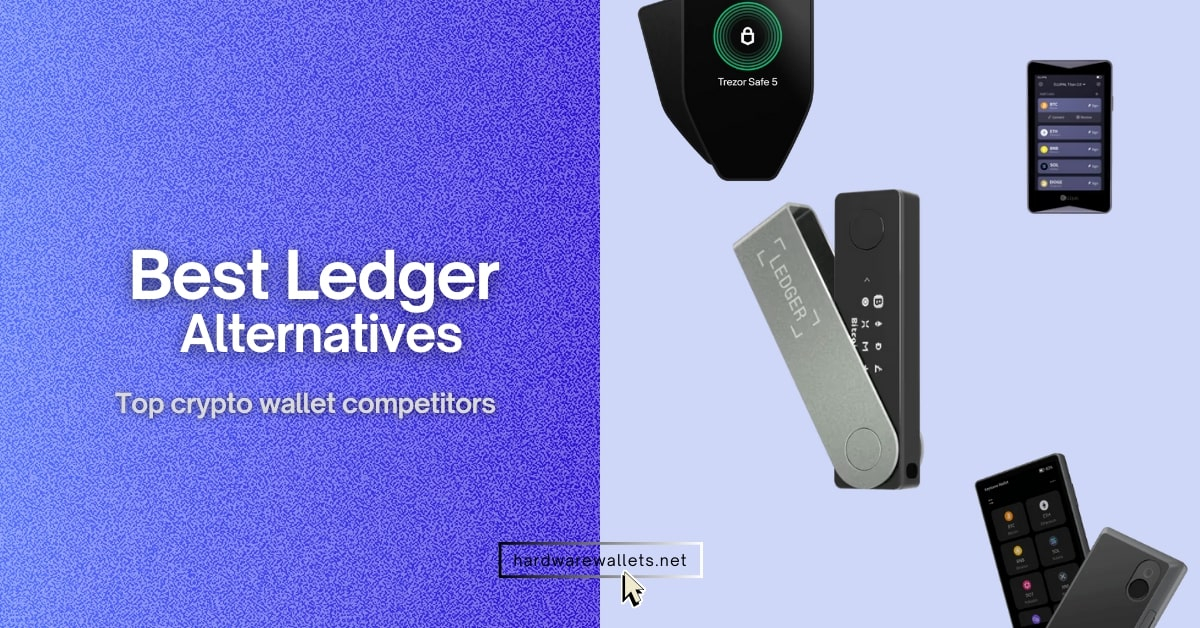Quick Summary: The best alternatives to Ledger are the Trezor Safe 5, ELLIPAL Titan 2.0, Keystone 3 Pro, SafePal X1, and BitBox02. Well, these wallets are best known for their strong security, ease of use, and overall good value.
Generally speaking, hardware wallets are the best way to secure your digital assets, and the Ledger brand has been a top choice for a long time. However, today, there are some really great Ledger wallet competitors out there, and a few of them might even be a better fit for you.
This guide will give you a detailed look at the 5 best Ledger alternatives. You will learn about their features, what makes them unique, and most importantly, why you might want to switch to one.
Top 5 Best Ledger Wallet Alternatives Ranked
I have reviewed more than 30 hardware wallets by testing their security, ease of use, and coin support. So, after comparing features, prices, and real user experience, I found the ones that stand out. According to my research, these are the 5 best Ledger alternatives you can buy:
- Trezor Safe 5: Best Ledger alternative for open-source security and advanced 20-word backup.
- ELLIPAL Titan 2.0: User-friendly air-gapped cold wallet for QR-code transactions and 10,000+ coin support
- Keystone 3 Pro: Most secure Ledger competitor with triple EAL5+ secure chips and multi-seed setup
- SafePal X1: Budget-friendly Ledger alternative wallet that supports 200+ blockchains for under $70
- BitBox02: Minimalistic Swiss wallet with open-source firmware and microSD backup options
Comparison Table Between All Ledger Wallet Competitors
For better understanding, here is a quick comparison between all these Ledger alternative options…
| Wallet | Price (USD) | Display size & type | Connectivity | Secure chip level | Supported chains | Standout feature |
|---|---|---|---|---|---|---|
| Trezor Safe 5 | ~$169 | 1.54″ color touchscreen | USB‑C only | EAL6+ | 8,000+ coins & tokens | Open‑source firmware & microSD backup |
| ELLIPAL Titan 2.0 | ~$129 | 4.0″ color IPS screen | Air‑gapped QR codes | EAL5+ | 10,000+ tokens, 40+ chains | Air‑gapped with an anti‑tamper body |
| Keystone 3 Pro | ~$149 | 4.0″ LCD with camera | QR & microSD | Triple EAL5+ | 5,500+ | Three secure elements & self‑destruct |
| SafePal X1 | ~$69.99 | 1.8″ monochrome screen | Bluetooth 5.0 & USB | EAL5+ | 200+ chains, unlimited tokens | Budget price with a rich app ecosystem |
| BitBox02 | ~$129 | Minimal LED indicators | USB‑C only | Dual secure chips | Bitcoin, Ethereum, 1,500 ERC‑20 tokens | MicroSD backups & Bitcoin‑only version |
Find Best Alternatives to Ledger Crypto Wallet
1. Trezor Safe 5

The Trezor Safe 5 is our #1 best Ledger alternative wallet, especially if you value open-source transparency and a great user experience. Safe 5, which was launched in 2025, has a large, vibrant touchscreen with haptic feedback. So, it kind of feels like you are interacting with a small smartphone.
The device is built with a tough Gorilla Glass screen and has a tamper-evident casing. Also, for transactions, it requires you to physically confirm every single one on the device itself, so you know exactly what you are signing.
The Trezor Safe 5 also includes an advanced 20-word backup that you can split into multiple parts for even better security, and its open-source approach means that the code is always being reviewed by the community. Hence, Trezor is a top alternative to Ledger because it combines a secure element chip with a completely open-source architecture, which is quite a different approach from Ledger’s more closed, proprietary system.
What I like
- Beautiful color touchscreen with excellent haptic feedback
- Completely open-source software for community auditing
- Upgraded EAL6+ secure element for better physical protection
- Enhanced 20-word backup with advanced multi-share options
- Easy and intuitive to set up and use
- Connects directly to modern devices with USB-C
What I don’t like
- Does not have a built-in battery, so it needs to be connected
- No Bluetooth for mobile-only use
- The Trezor Suite app is not available for iOS users
2. ELLIPAL Titan 2.0

ELLIPAL Titan 2.0 is another top option for anyone who wants a completely air-gapped wallet. That means it has no Bluetooth, no Wi-Fi, and no USB connection. Seriously, this device only communicates using QR codes.
So, you just need to scan a QR code from your phone’s app onto the wallet and then scan a new code back. This makes it totally resistant to online attacks and remote hacking attempts, which is the main reason it’s such a great alternative to Ledger.
The device itself is built solidly, as it has a full metal-sealed body that is designed to self-destruct and wipe all data if someone tries to physically tamper with it. Also, it has a large 4-inch color touchscreen, so you can clearly see what you are doing before you sign a transaction.
What I like
- 100% air-gapped, no USB or Bluetooth connections
- Tamper-proof metal body that self-destructs
- Large 4-inch color touchscreen for clear viewing
- Supports a wide variety of blockchains and over 10,000 tokens
- QR code-based transaction signing is very transparent
- Built with a strong CC EAL5+ certified secure element
What I don’t like
- The QR code process can feel a little bit slow
- The device is a bit big and clunky compared to a Ledger Nano X
- You need a microSD card to update the firmware
- The app ecosystem is not as broad as Ledger Live
3. Keystone 3 Pro

Keystone 3 Pro is a third‑generation wallet born from the Cobo Vault project. Here, the standout feature is its triple secure element design. Inside, three separate EAL5+ secure chips work together, so one generates your keys, another signs transactions, and the third validates firmware integrity.
Again, the wallet uses a fully air-gapped design just like ELLIPAL, so it communicates with your phone using QR codes. The device has a nice, big 4-inch touchscreen and is powered by four replaceable AAA batteries. Well, this is kinda different from Ledger wallets, but it means you don’t have to worry about a built-in battery dying out over time.
Basically, it’s an open-source wallet that is made to be as secure as possible by keeping your private keys totally offline. Guess what, it even works with a lot of third-party wallets like MetaMask and Rabby. The 3 Pro wallet supports multiple blockchains, including Bitcoin, Ethereum, and Solana.
What I like
- Completely air-gapped design with no physical connection
- Three separate Secure Element chips for top-level security
- Fingerprint sensor for quick and secure login
- Uses replaceable AAA batteries, so no battery-life worries
- Open-source firmware for transparent security and privacy
- Works well with many popular software wallets, like OKX Wallet, Rabby, MetaMask, etc.
What I don’t like
- The design is a bit bulky and not as pocket-friendly
- The companion app is not good, so you must use MetaMask or another third-party wallet
- No wireless connectivity means slower transaction workflows
4. SafePal X1

The SafePal X1 is the best Ledger alternative if you are on a budget but still want strong security. Well, it is a very affordable alternative to Ledger, just $69, but it doesn’t really skip on important features. The X1 uses high-speed Bluetooth 5.0 to connect to the SafePal app. The app is also feature-rich, includes staking, NFTs, DeFi access, and more.
The X1 is part of the SafePal family, which also includes the S1 and S1 Pro. But, unlike those air‑gapped models, this one connects wirelessly to your phone through the SafePal app. There’s also a USB‑C port for charging, and its 1.8‑inch monochrome screen has a 128×64 resolution, and the interface uses several physical buttons on the sides for menu navigation.
You also get an A CC EAL5+ secure element chip that protects your private keys, and even a top-tier self‑destruct mechanism wipes data after multiple incorrect PIN attempts.
What I like
- Very low price makes it accessible to most users
- Bluetooth 5.0 connects easily to phones and computers
- Supports over 200 blockchains and unlimited tokens
- Self‑destruct mechanism protects against brute‑force attacks
- SafePal app enables staking, NFTs, and banking services
What I don’t like
- No large, color touchscreen like Ledger premium models
- The battery life is only 2 hours on a full charge
- Monochrome 1.8‑inch screen feels dated compared to rivals
5. BitBox02

BitBox is another one of the best Ledger alternatives. The BitBox02 from Swiss company Shift Crypto takes a minimalist approach. So, the device is tiny and made from durable plastic, with a built‑in USB‑C connector that plugs directly into your computer or smartphone.
Mainly, it uses invisible touch sensors along the sides instead of physical buttons, which makes the design sleek and reduces moving parts. Also, the firmware is fully open source and has been audited by independent security researchers.
Inside, there’s a dual‑chip architecture: one microcontroller and one secure chip that stores keys separately. The wallet supports multiple cryptocurrencies, including Bitcoin, Ethereum, Litecoin, and more than 1,500 ERC‑20 tokens.
What I like
- Automatic backup to a microSD card is very convenient
- Direct USB-C connection, no cables needed
- Invisible touch sensors are a unique and intuitive design
- Made by a Swiss company, known for strong privacy laws
- Open-source firmware for good transparency
- Offered in a dedicated Bitcoin-only edition
What I don’t like
- Supports fewer cryptocurrencies than other multi-asset wallets
- No Bluetooth or wireless connectivity
- The screen is small and monochromatic
- You have to keep the microSD card safe, as it’s an unencrypted backup
Methodology: How to Pick Your Best Ledger Alternatives
To pick your best ledger alternative wallets, you need to consider factors like the security model, whether it’s open or closed-source, the user interface and ease of use, supported coins and tokens, connectivity, price and value, and the backup method.
- Security Model (Air-Gapped vs. Wired): This is likely the most important thing to consider. An “air-gapped” wallet, such as the ELLIPAL or Keystone, has zero physical or wireless connections whatsoever. So, it connects only through QR codes. Other wallets, such as Trezor or BitBox02, utilize a direct USB connection, which is still enormously safe but adds a very little bit of exposure. You need to determine which degree of separation you’re most at ease with.
- Open-Source vs. Closed-Source: You know, this is a large controversy in the cryptocurrency space. An open-source wallet has its code openly available, so anyone can verify it’s not vulnerable to attack. A closed-source wallet has its code hidden, but is backed by third-party security certifications (such as Ledger). So, neither is inherently “better,” it’s just a matter of whether you find a community-audited system or a certified, proprietary one more trustworthy.
- User Interface & Ease of Use: Actually, how you’re going to use the cryptocurrency wallet is really crucial. Some of the wallets have large, gorgeous color touchscreens (Trezor Safe 5, ELLIPAL), which can make using it feel much more intuitive. But others have smaller screens and button presses (SafePal X1, BitBox02). So, consider what feels most comfortable for you, and do you want something that feels like a small smartphone, or a bare-bones device?
- Supported Coins & Tokens: You have to ensure your new wallet supports all the cryptocurrencies you hold. Some wallets, such as the BitBox02 Bitcoin-only variant, are highly specific, and others, like the SafePal X1, support an enormous quantity of chains and tokens.
- Price & Value: You know, hardware wallets can be very cheap, but also expensive. A low-cost one like the SafePal X1 provides a lot of security for very little cost, which is ideal if you’re new to crypto or just keeping a small quantity of crypto. But again, if you want to spend a little more on a more expensive experience with a larger screen and additional features, an option like a Trezor or ELLIPAL will cost you.
- Backup Method: Today, most of the cold wallets employ a 12 or 24-word “seed phrase” that you must jot down. Some even support multisig and Shamir backup. The BitBox02 has a good function where it auto-backs up to a microSD card, which makes the setup a breeze at first.
Related FAQs
Which Ledger alternative is best?
Trezor Safe 5 and ELLIPAL Titan 2.0 are two of the best alternative wallets to Ledger. But again, it also depends on what you need most from a hardware wallet.
So, if you want the best open-source transparency and a great touchscreen experience, the Trezor Safe 5 is a perfect choice. The ELLIPAL Titan 2.0 or Keystone 3 Pro are your best bet if you want absolute physical isolation and air-gapped storage with no wireless connections.
Is Trezor safer than Ledger?
Well, Trezor is not safer than Ledger, but it is also a highly secure device. Trezor devices use fully open‑source firmware and hardware designs, which allows the community to review the code. The Safe 5 even uses an EAL6+ secure element and offers on‑device passphrase entry, whereas Ledger’s secure element is certified to EAL5+, but its firmware is closed source and controlled by the company.
So, honestly, the safety really comes down to whether you trust a closed, certified system more or an open, community-reviewed system. Both are extremely secure for storing your crypto. You can read my full Ledger vs Trezor comparison.
What are the best Bluetooth cold wallets other than Ledger?
The best Bluetooth cold wallets other than Ledger are mainly the SafePal X1 and SecuX V20.
The SafePal X1 gives you a great balance of security and affordability, and its Bluetooth 5.0 connection is really super fast for on-the-go transactions. Next, the SecuX V20 is also a solid option that offers a large color touchscreen and good Bluetooth connectivity.
Is the Ledger hardware wallet still safe to store crypto?
Yes, Ledger wallets like the Nano X and Nano S Plus are still considered safe by most security experts. And this is because they use an EAL5+ secure element chip and have passed multiple security audits.
The controversy you might have heard about came from the optional Ledger Recover service announced in 2023, as it mainly allows users to back up their seed phrase via encrypted shards stored with third‑party custodians.
Yes, this service sparked debate because private keys had to leave the device, even though it was encrypted. So, the point is, if you don’t enable this feature, nothing changes in how your keys are stored. As long as you keep your firmware up to date and avoid phishing scams, a Ledger device remains a trusted way to store crypto.
Why do you want to switch from Ledger to another wallet?
There are a few reasons you might be thinking about switching…
- First, you may feel uncomfortable or not secure with closed‑source firmware and the possibility of proprietary backdoors. So, open‑source crypto wallets like Trezor and BitBox02 let you and other community members verify every line of code.
- Second, you might want features that Ledger doesn’t provide. To start with, ELLIPAL’s air‑gapped design ensures your keys never touch a network, and Keystone’s triple secure elements offer unmatched redundancy.
- Third, price could be a factor. SafePal’s X1 costs less than half of a Ledger Nano X but still supports hundreds of blockchains.
- Finally, you may prefer a wallet that aligns with your personal values, whether that means open‑source principles, Swiss manufacturing, or simply avoiding a company that triggered controversy. So, whatever your reason, the good news is that there are plenty of best Ledger alternatives for storing your crypto securely.
If you are looking for more Ledger crypto wallet alternatives, check out my list of the best cold storage wallets and best crypto hardware wallets.
